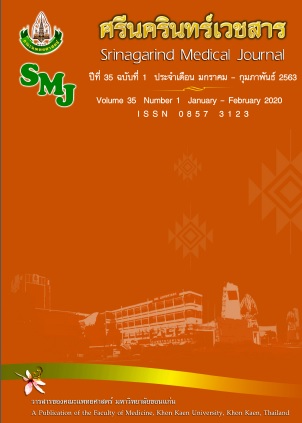ระดับความรู้เรื่องการวัดความดันโลหิตด้วยตัวเองที่บ้านของแพทย์เวชศาสตร์ครอบครัวในประเทศไทย
คำสำคัญ:
การวัดความดันโลหิตด้วยตัวเองที่บ้าน; ระดับความรู้; แพทย์เวชศาสตร์ครอบครัวบทคัดย่อ
หลักการและวัตถุประสงค์: ผู้ป่วยความดันโลหิตสูงควรวัดความดันโลหิตด้วยตนเองที่บ้านโดยได้รับคำแนะนำที่ถูกต้องจากบุคลากรสุขภาพ แต่ยังไม่พบข้อมูลเกี่ยวกับระดับความรู้ของแพทย์เวชศาสตร์ครอบครัว การศึกษานี้จึงมีวัตถุประสงค์เพื่อศึกษาระดับความรู้ และปัจจัยที่มีความสัมพันธ์กับระดับความรู้เรื่องการวัดความดันโลหิตด้วยตัวเองที่บ้านของแพทย์เวชศาสตร์ครอบครัว
วิธีการศึกษา: เป็นการศึกษาเชิงพรรณาแบบภาคตัดขวางในแพทย์เวชศาสตร์ครอบครัวที่มีชื่อในทะเบียนของราชวิทยาลัยแพทย์เวชศาสตร์ครอบครัว ณ ปี พ.ศ. 2560 ใช้แบบสอบถามโดยให้ตอบเอง วิเคราะห์ข้อมูลด้วยสถิติเชิงพรรณาและสถิติไคสแควร์ แบ่งระดับความรู้เป็น 3 ระดับ คือ ความรู้ระดับดี (คะแนนตั้งแต่ร้อยละ 80 ขึ้นไป) ปานกลาง (คะแนนร้อยละ 60-79.99) และต่ำ (คะแนนต่ำกว่าร้อยละ 60)
ผลการศึกษา: มีผู้เข้าร่วมวิจัย 172 ราย เป็นเพศหญิง ร้อยละ 59.3 ช่วงอายุ 30-39 ปี ร้อยละ 56.98 ให้แนะนำผู้ป่วยอย่างสม่ำเสมอในการวัดความดันโลหิตด้วยตัวเองที่บ้านร้อยละ 38.95 ผู้เข้าร่วมวิจัยส่วนมาก ร้อยละ 79.07 มีความรู้อยู่ในระดับต่ำ โดยปัจจัยต่าง ๆ ได้แก่ เพศ อายุ อายุการทำงาน สถานที่ทำงาน การเคยรับการอบรมเรื่องความดันโลหิตสูง และความถี่ในการให้แนะนำ ไม่มีความสัมพันธ์กับระดับความรู้อย่างมีนัยสำคัญทางสถิติ
สรุป: แพทย์เวชศาสตร์ครอบครัวส่วนมากมีความรู้เรื่องการวัดความดันโลหิตด้วยตัวเองที่บ้านระดับต่ำ และไม่พบปัจจัยที่มีความสัมพันธ์กับระดับความรู้อย่างมีนัยสำคัญทางสถิติ
เอกสารอ้างอิง
2. Kochanek KD, Xu J, Murphy SL, Minino AM, Kung HC. Deaths: final data for 2009. Natl Vital Stat Rep. 2011;60 :1-116.
3. อัจฉรา ภักดีพินิจ, ศกลวรรณ แก้วกลิ่น และสุภาพร พรมจีน. ประเด็นสารรณรงค์วันความดันโลหิตสูงโลก ปี 2559 [อินเทอร์เน็ต]. กรุงเทพฯ: สำนักโรคไม่ติดต่อ กรมควบคุมโรค; 2559 [เข้าถึงเมื่อ 28 มีนาคม 2561]. เข้าถึงได้จาก http://www.thaincd.com/document/file/info/non-communicable-disease/%E0%B8%9B%E0%B8%A3%E0%B8%B0%E0%B9%80%E0%B8%94%E0%B9%87%E0%B8%99%E0%B8%AA%E0%B8%B2%E0%B8%A3%E0%B8%A3%E0%B8%93%E0%B8%A3%E0%B8%87%E0%B8%84%E0%B9%8C%E0%B8%A7%E0%B8%B1%E0%B8%99%E0%B8%84%E0%B8%A7%E0%B8%B2%E0%B8%A1%E0%B8%94%E0%B8%B1%E0%B8%99%E0%B9%82%E0%B8%A5%E0%B8%AB%E0%B8%B4%E0%B8%95%E0%B8%AA%E0%B8%B9%E0%B8%87%E0%B8%9B%E0%B8%B52559.pdf
4. Chobanian AV, Bakris GL, Black HR, Cushman WC, Green LA, Izzo JL, Jr., et al. The Seventh Report of the Joint National Committee on Prevention, Detection, Evaluation, and Treatment of High Blood Pressure: the JNC 7 report. Jama 2003;289 :2560-72.
5. National Institute for Health and Care Excellent. Hypertension in adults: diagnosis and management [Internet]. 2019 [cited 5 Oct 2019]. Available from https://www.nice.org.uk/guidance/ng136/chapter/Recommendations#measuring-blood-pressure
6. Leung AA, Nerenberg K, Daskalopoulou SS, McBrien K, Zarnke KB, Dasgupta K, et al. Hypertension Canada's 2016 Canadian Hypertension Education Program Guidelines for Blood Pressure Measurement, Diagnosis, Assessment of Risk, Prevention, and Treatment of Hypertension. Can J Cardiol 2016;32 :569-88.
7. Parati G, Stergiou GS, Asmar R, Bilo G, de Leeuw P, Imai Y, et al. European Society of Hypertension practice guidelines for home blood pressure monitoring. J Hum Hypertens 2010; 24 : 779-85.
8. Centers for Disease Control and Prevention. Self-Measured Blood Pressure Monitoring: Action Steps for Public Health Practitioners. Atlanta, GA: Centers for Disease Control and Prevention, US Dept of Health and Human Services; 2013.
9. Sharman JE, Howes FS, Head GA, McGrath BP, Stowasser M, Schlaich M, et al. Home blood pressure monitoring: Australian Expert Consensus Statement. J Hypertens 2015; 33 :1721-8.
10. สมาคมโรคความดันโลหิตสูงแห่งประเทศไทย. แนวทางการรักษาโรคความดันโลหิตสูงในเวชปฏิบัติทั่วไป (ฉบับปรับปรุง พ.ศ.2558) [อินเทอร์เน็ต]. 2558 [เข้าถึงเมื่อ 28 มีนาคม 2561]. เข้าถึงได้จาก: http://www.thaihypertension.org/files/GL%20HT%202015.pdf
11. Gelfer M, Dawes M, Kaczorowski J, Padwal R, Cloutier L. Diagnosing hypertension: Evidence supporting the 2015 recommendations of the Canadian Hypertension Education Program. Can Fam Physician 2015; 61 :957-61.
12. Petrella RJ. Moving Forward: Family Physicians & Hypertension. Perspectives in Cardiology. 2004.
13. Kaczorowski J, Myers MG, Gelfer M, Dawes M, Mang EJ, Berg A, et al. How do family physicians measure blood pressure in routine clinical practice? National survey of Canadian family physicians. Can Fam Physician 2017; 63 :e193-e9.
14. Obara T, Ohkubo T, Fukunaga H, Kobayashi M, Satoh M, Metoki H, et al. Practice and awareness of physicians regarding home blood pressure measurement in Japan. Hypertens Res 2010; 33 :428-34.
15. Baral-Grant S, Haque MS, Nouwen A, Greenfield SM, McManus RJ. Self-Monitoring of Blood Pressure in Hypertension: A UK Primary Care Survey. Int J Hypertens 2012; 2012.
16. Levy J, Gerber LM, Wu X, Mann SJ. Nonadherence to Recommended Guidelines for Blood Pressure Measurement. J Clin Hypertens (Greenwich) 2016; 18 :1157-61.
17. Tirabassi J, Fang J, Ayala C. Attitudes of primary care providers and recommendations of home blood pressure monitoring--DocStyles, 2010. J Clin Hypertens (Greenwich) 2013; 15 : 224-9.




